

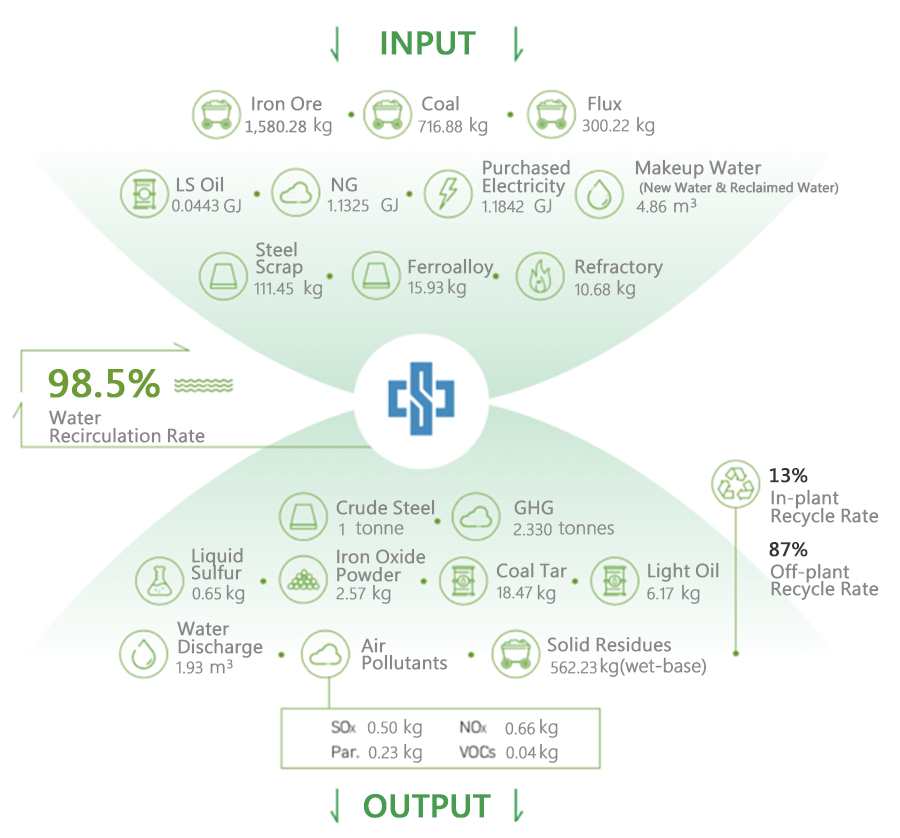
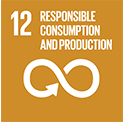
Taiwan's SDGs (T-SDGs) :
Core Objective 8(8.4)、12(12.2)
| Short-term goals (2023) | Mid-term goals (2025) | Long-term goals (2030) |
|---|---|---|
| Number of suppliers accepting the Supplier Code of Conduct ≥ 2,550 | Number of suppliers accepting the Supplier Code of Conduct ≥ 3,000 | Number of suppliers accepting the Supplier Code of Conduct ≥ 3,500 |
CSC is the largest upstream steel production plant in Taiwan. The main products are steel plates, steel bars, wire rods, electromagnetic steel coils, galvanized steel coils and others. The main raw materials used are coal, iron ore and flux; the majority of the raw materials are imported. In recent years, the raw materials market has changed from a buyer's market to a seller's market; therefore, the management of raw materials is one of the important determining factors for the steel plant to produce and make profit.
Besides, adjusting raw material stock according to domestic and international situations during weekly meetings on material purchase, transportation, and storage, CSC should also actively develop new materials and new sources. CSC also actively develops new sources for raw materials and recycles steel scrap in order to reduce costs, diversify sources, and avoid material shortages and monopoly by suppliers.
| Category | Raw materials | 2022 Usage (Unit: 10,000 tonnes) |
|---|---|---|
| Non-recyclable | Coal | 604.9 |
| Iron Ore | 1,333.4 | |
| Flux | 253.3 | |
| Recyclable | Steel Scrap | 94.0 |
![]() Use of Raw Material and Percentage of Purchasing by Country from 2020 to 2022
Use of Raw Material and Percentage of Purchasing by Country from 2020 to 2022
| Event | 2020 | 2021 | 2022 | |
|---|---|---|---|---|
| Purchase amount (10,000t) | 251 | 322 | 257 | |
| Country % | Japan | 44.22 | 44.79 | 52.03 |
| Taiwan | 20.32 | 17.02 | 17.92 | |
| Vietnam | 13.94 | 8.46 | 8.87 | |
| Philippines | 12.01 | 17.49 | 10.91 | |
| Others | 9.51 | 12.24 | 10.27 | |
| Event | 2020 | 2021 | 2022 | |
|---|---|---|---|---|
| Purchase amount (10,000t) | 733 | 798 | 696 | |
| Country % | Australia | 76.81 | 78.03 | 80.41 |
| Canada | 16.78 | 15.83 | 16.04 | |
| Indonesia | 2.59 | 4.17 | 1.54 | |
| Others | 3.82 | 1.97 | 2.01 | |
| Event | 2020 | 110年 | 111年 | |
|---|---|---|---|---|
| Purchase amount (10,000t) | 1,324 | 1,694 | 1,390 | |
| Country % | Australia | 83.01 | 73.79 | 78.42 |
| Brazil | 9.67 | 16.34 | 14.19 | |
| Canada | 7.32 | 9.87 | 7.39 | |
| Others | - | - | - | |
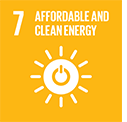
Taiwan's SDGs (T-SDGs) : Core Objective 7, 8,11,12
CSC mainly implements energy management through the Energy Conservation Committee and control of the energy management system (ISO 50001) to achieve the goals of energy conservation, carbon reduction and continual improvement. The Committee was formed and chaired by VP of Production Division. The Committee has three teams be responsible for energy saving and emission reduction in CSC's plants. The Committee also regularly holds meetings to review the achievement of current targets, share information on energy conservation projects, communicate relevant important topics, bring up appeals or consultations, propose interim motions, and publicize the records of the meeting. The energy policies are approved by the Chairman of the Board and updated when necessary. The latest version of the Energy Policy is committed to continuous improvement, compliance with regulations, performance management, energy conservation, carbon reduction, and knowledge advancement.
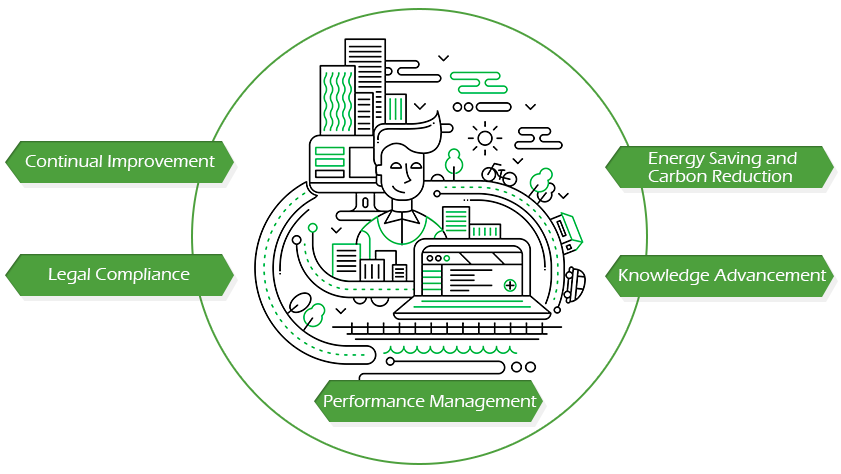
| Continual Improvement | Improve energy performance, support energy-saving designs and green procurement, and commit to sustainable operations. |
|---|---|
| Legal Compliance | Implement legal identification, comply with energy regulations, and fulfill corporate social responsibility. |
| Performance Management | Perform energy reviews, fully provide resources and information to achieve goals/targets, and eliminate potential energy waste. |
| Energy Saving and Carbon Reduction | Become an environmentally friendly steel company dedicated to improving energy efficiency, promoting district energy integration, developing green energy, and using clean energy. |
| Knowledge Advancement | Capture the latest energy technical opportunities, reach communication consensus and achieve widespread application. |
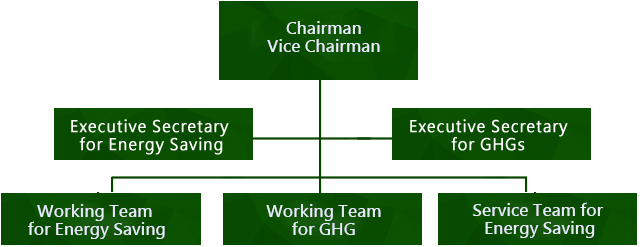
In order to improve energy efficiency and achieve continuous improvement, CSC sets the energy intensity target (Mcal/tCS) according to the annual production plan and energy saving goals every year, as the energy performance indicator. The energy intensity target for 2023 is≦5,436 Mcal/tCS (22.76 GJ/tCS ).
| Item | 2020 | 2021 | 2022 | 2023 |
|---|---|---|---|---|
| Energy Intensity Target (Mcal/tCS) |
≦5,614 | ≦5,390 | ≦5,522(I) | ≦5,436 |
| Energy Intensity Target (GJ/tCS) |
≦23.50 | ≦22.57 | ≦23.12 | ≦22.76 |
| Actual Energy Intensity (Mcal/tCS) |
5,549 | 5,315 | 5,485 | - |
| Actual Energy Intensity (GJ/tCS) |
23.23 | 22.25 | 22.96 | - |
| Accomplishment | Yes | Yes | Yes | - |
Note: The target of Energy Intensity is set based on production capacity and equipment maintenance that year. The steel market was still in poor condition in the second half of 2022, production of the blast furnace was adjusted accordingly, and the energy baseline has deviated from the original basis used for goal programming. Hence, the target value for Energy Intensity in 2022 was adjusted for management and to make the target feasible.
ISO formally announced ISO 50001 in June 2011. In order to improve the performance of energy conservation, CSC introduced ISO 50001 in February 2011 along with consultation from Industrial Technology Research Institute (ITRI), and received the certificate of ISO 50001 from BSI on December 1st of the same year. CSC is the first steel company to implement ISO 50001 in Taiwan, and obtained ISO 50001:2018 certification in 2019. CSC continues to pass verifications by third party institutions each year, and achieves energy conservation, carbon reduction, and continuous improvement goals through its management system and the Energy Conservation Committee.
In order to achieve energy conservation and carbon reduction and respond to mandatory Greenhouse Gas (GHG) reductions in advance, CSC started the “Five-year Energy Saving Action Plan” in 2005, and has successively promoted three phases and every phase has reached the targets of the action plan. 553 energy-saving projects were completed in 2021-2022, contributing to 82% of the “Energy Saving Action Plan -Phase IV” target (the fourth phase is from 2021 to 2025), which is equivalent to a reduction in carbon emissions of 174,700 tonnes CO2e (I). At the same time, CSC adheres to the government's energy saving targets and regulations “The average annual power-saving rate of energy user shall reach 1% or more from 2015 to 2024”. Currently, CSC has achieved a power-saving rate of 1.89% from 2015 to 2022.
Note: I. The calculation coefficients are partially quoted from the CO2 emission factors of the GHG inventory in the previous year, and the rest are calculated based on CSC's energy equipment efficiency coefficient in 2014 x previous year's electricity emission coefficient from the Bureau of Energy.
| Phase | I Energy Saving Action Plan |
II Energy Saving Action Plan |
III Energy Saving Action Plan(I) |
IV Energy Saving Action Plan |
|---|---|---|---|---|
| Schedule | 2005 - 2010 | 2011 - 2015 | 2016 - 2020 | 2021 - 2025 |
| Energy-saving Target (GJ) | 8,666,676 | 9,043,488 | 3,784,624 | 2,637,684 |
| Number of Projects | 372 | 658 | 662 | 553 |
| Performances (GJ) | 8,930,444 | 12,623,202 | 6,253,473 | 2,174,657 |
| Achieving Rate | 103% | 139% | 165% | 82% |
Note I: Due to the diminishing energy-saving potential, the targets of Phase III and IV Energy Saving Action Plans are less than previous years. The number of projects, energy-saving performances and achieving rate are calculated until 2021.
▪ Set up Utilities Dispatching Center (UDC) CSC established the UDC since factory completed and put into production. The UDC centrally monitors all energy sources, such as gas, electricity, steam, O2, N2, Ar, H2, plant air, compressed air, etc., and also production plans. Then with the assistant of the integrated-Energy Management System (iEMS), UDC can execute dynamic dispatching in order to keep energy balancing in CSC and to minimize by-product gas emissions. UDC also manages the electricity load in CSC to avoid violating the contract with Taiwan Power Corp. (Taipower), and actively participates in the Taipower Demand Bidding Program. Furthermore, it compares the power generation cost of different fuels with Taipower tariff to adjust the self-generation amount to minimize the usage of high-priced fuels, such as low-sulfur oil and natural gas.
▪ Best Available Techniques (BAT)
In order to improve energy-saving performance, CSC has intensively contacted with steel-making companies in Japan, South Korea and China in recent years. We had collected BAT for energy-saving from other companies and completed the “Best Available Technical Manual for Energy Saving and Emission Reduction of Steel Plants” in July 2011.
The main technologies that have been applied in CSC are Coke Dry Quenching (CDQ), sinter waste heat recovery, Top Gas Pressure Recovery Turbine (TRT), Blast furnace hot stove waste gas heat recovery, Blast Furnace Pulverized-coal Injection, Converter Off-Gas Boiler, Gas recovery system for top hopper release, Hot Charging, Regenerative Combustion, etc.
▪ Guidelines of Energy Conservation Energy-saving begins with design. CSC adds the “Guidelines of Energy Conservation” section to CSC Design Standard and indicates energy efficiency requirements of air conditioning, lighting, shifting mechanisms, water supply systems, etc. New plants should follow the design standard to choose equipment that is high efficiency, energy saving with long-term benefits. To promote energy conservation design standards, energy conservation examples are periodically shared during energy and environment meetings of the Energy Conservation Committee and CSC Group, in hopes of further improving energy conservation results.
▪ Energy-Saving Technology Counseling Team
Through vertical integration and horizontal contact, CSC takes the lead in promoting the energy-saving technical service work to CSC's subsidiaries and mid- and downstream customers. With consultation on thermal, electricity, and energy management, the team hopes to discover more opportunities in energy-saving improvement, which further improves energy efficiency, reduces energy costs, and increases competitiveness. As a result, CO2 emissions are reduced, contributing to the voluntary reduction of greenhouse gas emissions in steel-related industries.
From 2007 to 2022, the team served a total of 69 manufacturers. The service target has been extended to mid- and downstream customers and their associates in the steel industry. CSC has fulfilled its corporate social responsibilities in order to improve industrial competitiveness and promote a friendly environment. In 2021, CSC provided energy saving and carbon reduction-related technical consulting services to two companies, namely Kaohsiung Monomer Co., Ltd. and Hanshin Department Store, in collaboration with the Kaohsiung City Energy Saving and Carbon Reduction Technical Consulting Team.
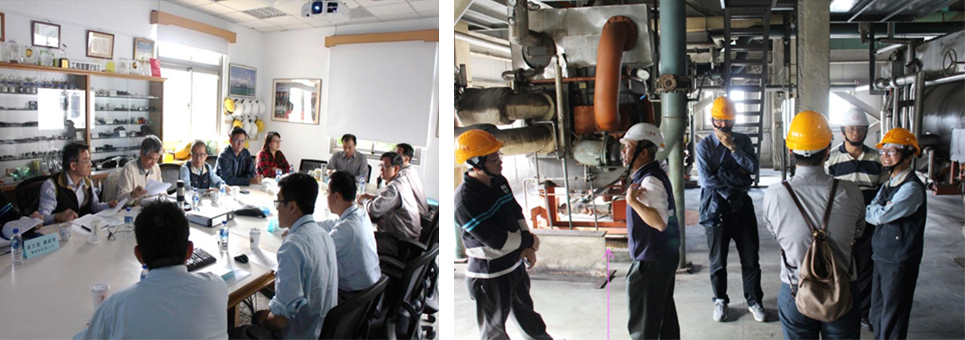
▪ Group Energy Saving Promotion To promote energy-saving measures and sharing case studies within the CSC Group, an energy-saving technology exchange platform, and share energy conservation examples during periodic group energy and environment meetings, in order to maximize the benefits from the group's energy conservation.
“Renewable Energy Development Act” have been passed in May 2019. National cumulative installation amount is projected to reach 27 GW in 2025, and large power consumers are required to set up a certain percentage of renewable energy power generation equipment. CSC Solar Corp. installed 92.4 MW solar photovoltaic equipment within the CSC Group from 2017 to 2022 to achieve energy saving, carbon reduction and fulfill corporate social responsibility. As of the end of 2022, the cumulative power generation reached 435 million kWh, and all the power generation was sold to Taipower. As the electricity emission coefficient of Taipower in 2021 was 0.509 kg/kWh, the carbon reduction generated by CSC's solar energy reached 221,000 tonnes, equivalent to the CO2 absorption of 569 Daan Forest Parks.
Following the installation of solar power systems in line with government policies since 2011, CSC's solar power installed capacity has reached 62.0 MW (including self-built and provided places) in 2022. Subsequent to the installation of four solar power charging stations for electric scooters with a total capacity of 30kW at CSC plants, these charging stations generated 24,795 kWh of electricity in 2022, with the electricity generated by these charging stations used at CSC plants. At the same time, CSC successfully obtained a total of 25 renewable energy certificates at the end of 2022. On the other hand, CSC has planned to use at least 30 million kWh of electricity generated from renewable energy each year starting in 2023 for the purpose of complying with the “Regulations for the Management of Setting up Renewable Energy Power Generation Equipment of Power Users above a Certain Contract Capacity.”
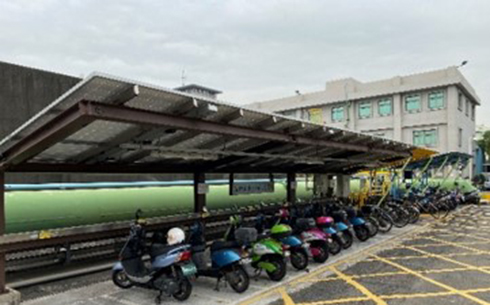
Solar power bike charging stations at the east side of W6/Y6 Dept. building
| 2020 | 2021 | 2022 | |
|---|---|---|---|
| CSC Accumulated Solar Power Capacity (MW) ( Including self-built and provided places) |
61.1 | 62.0 | 62.0 |
The coking coal in the steelmaking process transforms into by-product gases which can be used as fuel in steelmaking and in cogeneration power plants to generate steam and power. Oil and natural gas can also be used in power plants while the excess power demand is met by purchased electricity from Taipower.
| Category(I) | Item | 2020 Usage (GJ) | 2021 Usage (GJ) | 2022 Usage (GJ)(II) |
|---|---|---|---|---|
| Primary Energy | Coal(III) | 207,815,234 | 219,340,668 | 191,854,995 |
| NG | 3,082,331 | 5,107,395 | 9,556,139 | |
| Diesel Oil | 103,292 | 111,916 | 104,733 | |
| Gasoline | 5,953 | 5,368 | 4,997 | |
| Low-sulfur Oil | 68,615 | 79,477 | 373,631 | |
| Secondary Energy | Purchased Electricity | 8,918,640 | 9,600,438 | 9,991,953 |
| Self-Produced secondary energy | Steam | 11,692,499 | 10,755,248 | 10,791,457 |
| Coke Oven Gas (COG) | 35,070,654 | 36,497,632 | 36,300,085 | |
| Blast Furnace Gas (BFG) | 40,424,444 | 47,792,494 | 40,306,703 | |
| Linz-Donawitz Converter Gas (LDG) | 6,982,838 | 8,129,416 | 6,816,953 | |
| Cold Blast Air | 7,793,058 | 8,765,847 | 7,765,506 | |
| Oxygen | 942,972 | 1,129,754 | 1,049,466 | |
| Nitrogen | 713,866 | 764,360 | 769,522 | |
| Argon | 95,064 | 100,735 | 90,431 |
Note I: Primary Energy consumption and Secondary Energy consumption were verified by DNV in CSC's annual GHG inventory. Energy consumption for each type of energy source each year is determined by calculating the product of annual consumption and average heating value in CSC's annual test each year.
Note II: Consumptions of natural gas, low-sulfur oil, and purchased electricity were higher in 2022 and 2021 than in 2020 due chiefly to the cessation of coal combustion in boilers at CSC's power houses in August 2021, which eventually led to higher consumption of purchased electricity within the company and increased use of natural gas and low-sulfur oil at the company's power houses.
Note III: Coal in 2020 and 2021 includes metallurgical coal and steam coal; coal in 2022 only includes metallurgical coal.
In 2022, CSC completed a total of 234 energy saving projects, which saved a total of 1.317 million GJ, reduced carbon emissions by 86,000 tonnes CO2e, and saved energy cost by 417 million TWD, main projects include Rolling Mill Department II- Hot Rolled Products "changing reheating furnace No.3 of the first hot roller to regenerative," "improving fuel control of reheating furnace No. 2 of the first hot roller," and Rolling Mill Department I - Plate, Bar & Rod "optimizing combustion air emission valve of reheating furnace in Billet Mill to improve the energy consumption of the reheating furnace."
| Energy Saving Category | 2020 | 2021 | 2022 | |||
|---|---|---|---|---|---|---|
| Items | Items (GJ) | Items | Items (GJ) | Items | Items (GJ) | |
| Electricity | 111 | 298,099 | 106 | 223,820 | 169 | 486,750 |
| Fuel Gas | 13 | 569,392 | 8 | 172,350 | 17 | 664,063 |
| Industrial Gas | 4 | 25,364 | 7 | 47,292 | 2 | 3,865 |
| Steam | 5 | 146,544 | 5 | 108,472 | 6 | 107,150 |
| Water Systems | 11 | 9,244 | 170 | 13,190 | 25 | 2,162 |
| Others | 12 | 13,882 | 23 | 285,941 | 15 | 52,853 |
| Total | 156 | 1,062,525 | 319 | 851,065 | 234 | 1,316,843 |